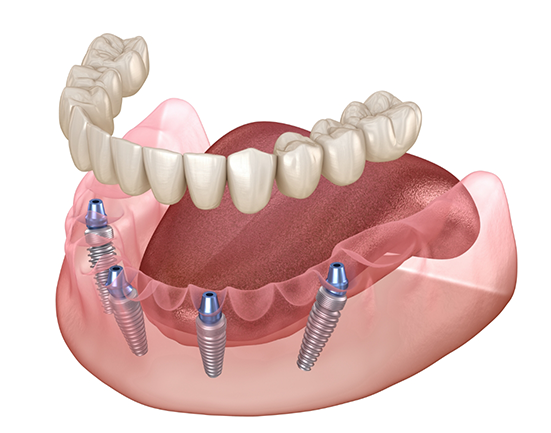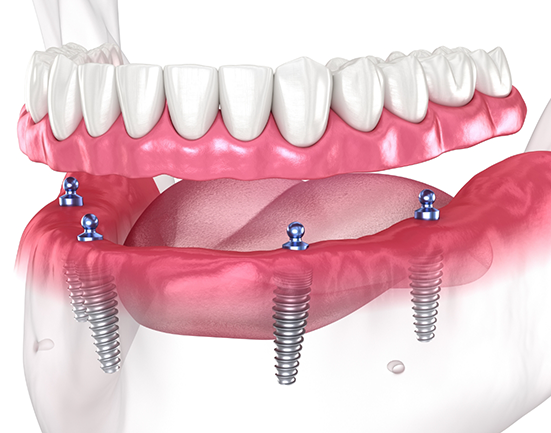All-On-4 Dental Implants Frisco
Achieving Better Oral Health with Only Four Implants

Do you lack necessary jawbone density? If so, you might believe you are ineligible for dental implants; however, this is not true. Dr. Gadhiya uses All-on-4 as an alternative option for those who desire permanent prostheses but lack the necessary density and strength to support an implant denture. With no bone grafting required beforehand, you can prepare to enjoy the same great results with only four dental implants, so call us today to find out if All-on-4 is right for you!
Why Choose Highland Oak Dental for All-On-4 Dental Implants?
- Dentist Who Can Place All-on-4 In-House
- We Personalize Each Dental Patient’s Experience
- Dental Team Will Review Your Insurance Benefits
What Are All-On-4 Dental Implants?

The All-on-4 (or 5, 6, 7, 8) refers to titanium metal screws or posts that are surgically installed into the patient’s jawbone (under the gums). These will serve as the base where your new teeth will be placed. Once they’ve fully healed, the dentist can now mount your new teeth on top of them.
The All-on-4 fixed prosthesis is the best option for permanently replacing missing teeth – up to eight in each jaw. What’s great about this alternative dental solution is that the patient doesn’t need to have new roots for each missing tooth. Simply put, the patient is no longer required to get a full replacement.
Instead, a minimum of four roots is enough to support a complete set of dentures. However, the patient can still get their permanent restorations placed on four to eight new roots in each jaw depending on their case. Once installed, this full mouth prosthesis will look, feel, and function almost like their natural teeth. With this, the patient is now able to eat and communicate naturally without any limitations.
How Does All-On-4 Work?

With the installation of their new permanent prosthesis, the patient can get All-on-4, All-on-5, All-on-6, or All-on-8 artificial roots attached to each jaw. These will provide support to either a removable or a fixed set of dentures. Normally, All-on-4 fixed prostheses are commonly used. This kind consists of two new roots that are placed in front of the patient’s jaw, while the remaining two will be placed in the back of the jaw at a 45° angle.
For cases where additional support and retention of the prosthesis is required, your dentist may opt to use 6 or 8 implants instead. However, this practice is rarely used, because this means the patient will need to have a thicker and greater volume of jawbones to support the enhanced number of titanium screws.
With this, the patient is now able to eat and communicate naturally without any limitations.
Benefits of All-On-4 Dental Implants

Undoubtedly, fixed prostheses have a couple of advantages compared to traditional alternatives like dentures and bridges. Below are five major benefits:
Convenience & Comfort

These fixed prostheses are strong, durable, and comfortable. Combined with the aesthetic appeal of fixed or removable partial dentures, patients will feel more satisfied and confident with their replacement teeth. In addition, they’ll be able to eat and speak naturally. Plus, thanks to these artificial roots, their new teeth will have a stable foundation that will support their new ones.
Gorgeous Aesthetic Results

Unlike traditional alternatives that require a few months before a prosthesis can be installed, the All-on-4 (or 5, 6, 7, 8) prosthesis can be instantly loaded together with the patient’s new teeth. This means patients will no longer need to wait for several months before getting the result they want – having a perfect smile.
Sturdy & Durable

Fixed prostheses are incredibly durable as compared to traditional dentures, which need to be repaired or replaced frequently. They will last even longer if you maintain good oral hygiene (brush regularly, floss, and rinse) and eat healthily.
Easy Recovery

Generally speaking, your dentist will make sure to perform as minimal surgery as possible, and since permanent restorations only need four artificial roots (in most cases), the recovery time is much faster, and the procedure is made easier for the patient.
Bone Grafting is Not Required

In the case of a fixed prosthesis, bone grafting is no longer required because it can be installed where the quality and quantity of bone are less pronounced. Normally, the effects of bone resorption are minimal, especially in the front portion of the jawbone. This means the two new roots in front are stable and can retain the prosthesis. Meanwhile, the remaining two screws or posts are placed at the back of the jaw at a 45° angle. Overall, a fixed prosthesis can be installed in cases where there is less space available between the upper and lower jawbone than usual. Furthermore, your dentist can even use mini implants to provide the same benefits in certain cases.








